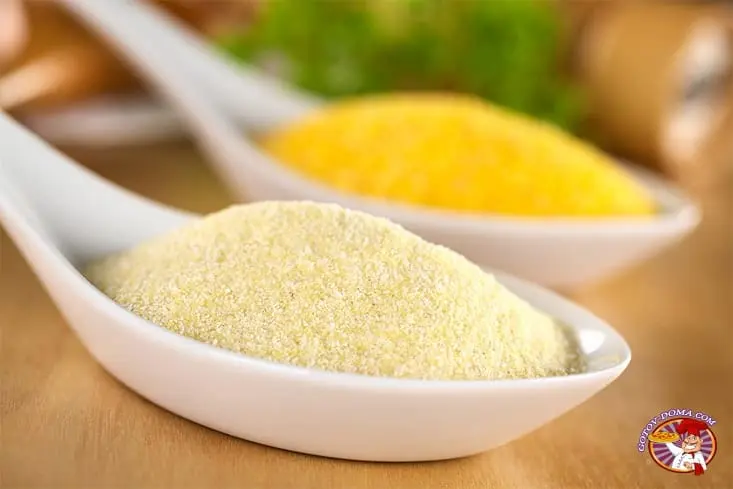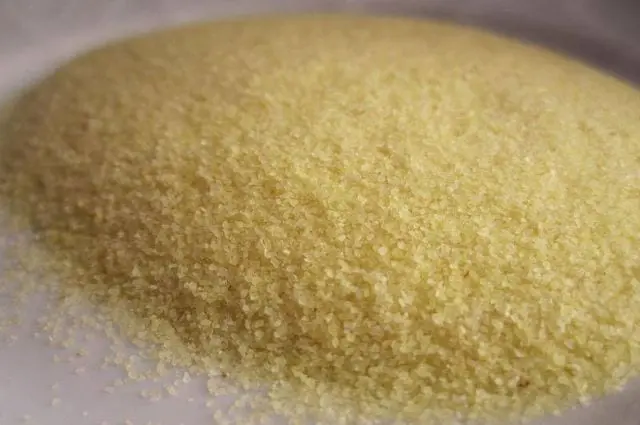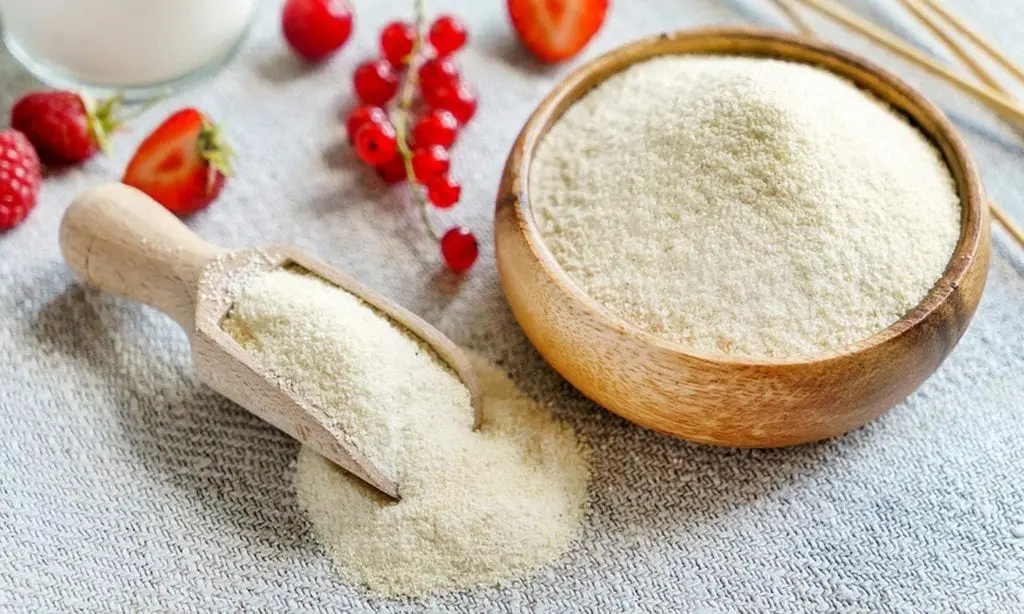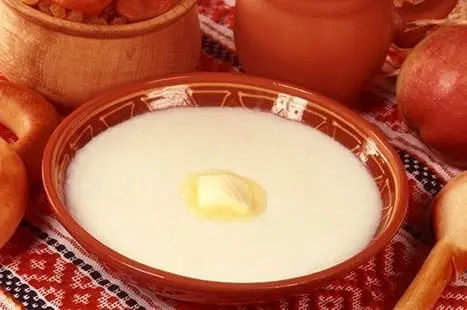Contents
Description
Semolina is the very dish about which there is a lot of controversies. It is very contradictory in its properties. The current generation is confident that, in addition to satiety and empty calories, it does not affect the body in any way, and representatives of the older generation do not doubt that semolina is one of the most useful foods. It’s time to dispel all doubts and write the truth about this mess.
What is semolina anyway? This porridge is the grain of ground wheat. It is good not only to make porridge but also to add to various baked goods, sauces, casseroles, and much more.
Semolina is popular among people during the recovery period after suffering infectious and non-infectious diseases and operations, the elderly, and people with digestive problems. You can include meals with semolina in the diet for children with underweight. But it is absolutely useless for healthy people, and its frequent consumption leads to rapid weight gain.
Semolina porridge contains gluten (gluten), which does not harm a healthy person. However, some people are gluten intolerant. The name for the condition is celiac disease, a severe hereditary disease that affects about one in 800 Europeans. Under the influence of gluten in celiac patients, the intestinal mucosa becomes thinner, and the absorption of nutrients and vitamins goes wother, and stool disorder is observed.
If you like semolina porridge, then you should not completely abandon its use. However, it should not be the main dish in the diet of adults and children.
And if you cook dishes from semolina, it is better to add fresh fruits or berries.
Composition and calorie content
The product contains vitamins B1, B2, B6, E, H, and PP, and the necessary minerals: potassium, calcium, magnesium, iron, cobalt, phosphorus, and sodium, starches. There is not much fiber in semolina, so it is ideal for “sparing” diets, recovery after abdominal surgery.
A distinctive feature of semolina is its ability to be digested and absorbed in the lower intestine without irritating its walls; this is important for those who suffer from gastrointestinal tract diseases, especially ulcers and gastritis. Semolina is good for maintaining the body’s weakened strength after illness, during a breakdown, or after a nervous breakdown.
- Caloric content 333 kcal
- Proteins 10.3 g
- Fat 1 g
- Carbohydrates 70.6 g
The history of semolina

Semolina is ordinary milled wheat; only its grinding is coarser than wheat flour.
Semolina appeared on our tables only by the 12th century and was inaccessible to most people. Due to its high cost, only noble people ate it, and then mainly during festive feasts.
But the love of porridge has always been characteristic of our people; they were prepared for every important event; they came up with many sayings about porridge. Although initially any porridge was cooked mainly in water or broths, with vegetables, fruits, meat; and only then – in milk.
They say that the love of this porridge among noble persons even saved the life of Alexander III. Once, the train in which the emperor was traveling derailed. The cars with the bedroom and Alexander’s office were destroyed. He himself escaped because he was in the surviving restaurant car and could not tear himself away from the creamy porridge.
Semolina has firmly entered our culture only in Soviet times. They began to make semolina from waste after processing wheat, and porridge became cheap and popular. It is interesting that abroad they do not like semolina in most countries. Many foreigners do not even know what it is, and after the “tasting,” they are often not happy. They say it looks like raw pancake dough.
Researchers associate this not only with other cultural traditions but also with biology. There is a lot of gluten in semolina, intolerance to which many Europeans suffer, and apparently subconsciously avoid a dangerous product.
Semolina Categories
All semolina produced in the world is usually divided into three categories, each of which corresponds to a specific type of wheat from which it was obtained.
- Category “S” is semolina, which is obtained by grinding soft wheat varieties.
- Second Category “SH” – groats obtained based on both soft and hard varieties.
- Category “H” – groats, which are obtained exclusively from hard varieties.
It is desirable to use each of these categories as intended. For example, semolina category “S” is more suitable for viscous and liquid dishes, as well as when it is necessary to bind the ingredients together into a homogeneous mass (minced meat). Groats of the category “H” will reveal themselves better in sweet dishes and bread.
But regardless of its category and contrary to popular belief, semolina is not useful for everyone, which is explained by its chemical composition and properties.
The benefits of semolina

Semolina contains much less fiber than many other bowls of cereal. Despite the need for fiber for digestion, it is practically excluded from the diet in some diseases. It causes gas and irritates the intestines, so low-fiber semolina is good for these patients. In the postoperative period, with a decline in strength, it is useful for recovery.
Semolina envelops the stomach and intestines’ mucous membranes, does not cause spasms, and is easily absorbed. This is important for many people with indigestion.
There are not many trace elements and vitamins in semolinas, as in other cereals, but there are still benefits. Semolina contains the most important B vitamins, as well as PP, potassium, and iron. Vitamin B1 is essential for the nervous system; it stimulates the brain. And vitamin B2 is involved in the synthesis of nerve cells. This vitamin also facilitates the absorption of iron and stimulates the maturation of red blood cells – erythrocytes. With a deficiency of B vitamins, dermatitis, and damage to the mucous membranes are possible.
The harm of semolina

Many modern doctors consider semolina porridge “empty” – in terms of the content of various substances, it loses to many other bowls of cereal. At the same time, semolina is extremely high in calories since it consists of fast carbohydrates. They digest quickly and, when consumed frequently, contribute to imperceptible weight gain. After processing fast carbohydrates, the feeling of hunger arises much faster.
Semolina also contains a lot of gluten, more commonly known as gluten. Gluten can cause intestinal villi necrosis and impair absorption. About one in eight hundred Europeans suffer from gluten intolerance – celiac disease. The disease is genetic and may not appear immediately. The degree of intolerance is also different – from heaviness in the stomach to severe intestinal inflammation.
For the same reason, semolina should not be given to children under 3 years old, and even at an older age, no more than a couple of times a week. A child’s stomach cannot digest such carbohydrates, and many babies are really intuitively unpleasant to eat semolina. If a child flatly refuses to eat such a dish, it is better not to force a “spoon for mom” into it. Of course, if a doctor does not recommend such food for some reason.
Semolina contains phytin. It contains a lot of phosphorus, which binds calcium salts and prevents it from entering the blood. It has been proven that many children who ate large portions of semolina daily suffered from rickets and other diseases due to the malabsorption of nutrients.
The use of semolina in medicine

Semolina porridge is digested only in the lower intestine, so doctors recommend it for diseases of the stomach and intestines. Porridge envelops the mucous membranes without causing heaviness, as it quickly “slips” further. Such a healing breakfast is useful for recuperating after a long illness.
Porridge saturates well, which is necessary for people during the rehabilitation period because they cannot eat meat and many products that cause gas formation.
The use in cooking

Semolina is essentially a large flour to be used in the same recipes as the last one. Porridge, pies, puddings are made from semolina, cutlets are rolled in it.
Most people associate semolina with sweet porridge for children. In fact, the range of application of semolina in cooking is much wider. And you can use it like this:
- As a filling in the preparation of the first course.
- For cooking dumplings, casseroles, and pancakes.
- Add to minced meat during the preparation of cutlets, meatballs, and sausages.
- As a breading for cutlets, meatballs, and zrazy.
- Semolina can be added to mousse, soufflé, and pudding.
- based on semolina, they prepare the world-famous pie – manna.
When using semolina, it is necessary to remember its peculiarity – it absorbs moisture very quickly and swells, increasing the volume of raw materials for the dish. Therefore, adding it during cooking, you must strictly follow the dosage and recipe recommendations.
Another feature of semolina is the almost complete absence of its own taste, well, except that little mealy notes exist. Therefore, the result depends on what products it is combined with. That is why, during the preparation of the same cereals based on semolina, it is customary to generously season the dish with milk, butter, sugar, jam, honey, or jams.
It is necessary to store semolina at home in a tightly sealed container. It absorbs moisture from the environment and tends to absorb all extraneous odors, significantly spoiling its taste in the final dish.
Sweet semolina recipe

INGREDIENTS
- Milk 1 glass
- Semolina 4 teaspoons
- A pinch of salt
- Sugar 2 teaspoons
COOKING INSTRUCTIONS
- Put semolina, salt, sugar in a separate bowl.
- A few seconds before the milk boils, pour the semolina with sugar and salt in a thin stream.
- After boiling, stir the porridge for 2-3 minutes over low heat, close the lid and wrap with a towel, and leave for 10-15 minutes.
- Add butter.









